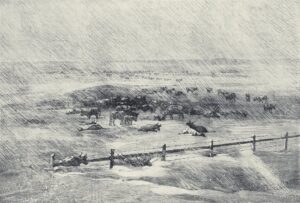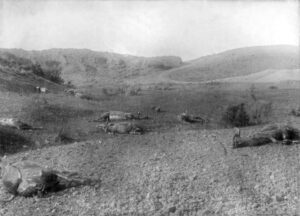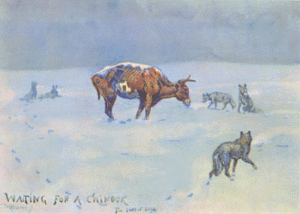
 Many people hate, or at least really dislike winter, but the cold and snow we normally see really isn’t so bad…at least not when compared to “the worst winter in the West,” which took place in 1886. During one of the harshest days of the “worst winter in the West,” nearly an inch of snow fell every hour for 16 hours, placing increased stress on the already starving cattle’s ability to find food.
Many people hate, or at least really dislike winter, but the cold and snow we normally see really isn’t so bad…at least not when compared to “the worst winter in the West,” which took place in 1886. During one of the harshest days of the “worst winter in the West,” nearly an inch of snow fell every hour for 16 hours, placing increased stress on the already starving cattle’s ability to find food.
Harsh winters in Montana, Wyoming, and the Dakotas was nothing new, but underestimating the coming winter can lead to disaster. The plains ranchers had seen severe winters in the past, but they had survived because their cattle were well-fed into the winter. By the mid-1880s, however, the situation had changed, and the winters had become mild. In hopes of making quick and easy money, greedy speculators had stocked the northern ranges in Montana, Wyoming, and the Dakotas. Deceived by the prior series of mild winters, many ranch managers had stopped putting up any winter feed. Then, in 1886, disaster struck.
The disaster began when that summer was hot and dry. Draught is often a precursor to big problems. By autumn, the range was almost barren of grass. That was bad enough, but then came the cold and snow, which came early. By January, record-breaking snowfalls blanketed the plains, forcing the already weakened cattle to expend vital energy just moving through the snow in search of the already scant forage. In January, a warm Chinook wind briefly melted the top layers of snow. The “January Thaw” is a well know phenomenon is this area. When the brutal cold returned…so brutal, that some ranches recorded temperatures of 63 below zero, a hard, thick shell of ice formed over the ground, making it almost impossible for the cattle to break through the snow to reach the meager amount of grass below. Unfortunately, the ranchers had become complacent, and with no winter hay stored to feed the animals, many ranchers had to sit by idly and watch their herds slowly starve to death. According to one historian, “Starving cattle staggered through village streets, and collapsed and died in dooryards.” In Montana, 5,000 head of cattle invaded the outskirts of Great Falls, eating the saplings the townspeople had planted that spring and “bawling for food.”
When the snow melted in the spring, the carcasses of the massive herds dotted the land as far as the eye could see. One observer noted that many rotting carcasses clogged the creeks and rivers, so that it was difficult to find water fit to drink. Millions of cattle are estimated to have died during the “Great Die-Up,” in a grimly humorous reference to the celebrated “Round-Up.” Montana ranchers alone lost an estimated 362,000 head of cattle, which was more than half of the territory’s herd.
The ill planned for disaster sent hundreds of area ranches into bankruptcy. The hard winter also brought an abrupt end to the era of the open range. Realizing that they could not predict future weather, the ranchers now understood that they would always need to grow crops to feed their animals, both in summer and winter. Ranchers began to reduce the size of their herds and to stretch barbed wire fences across the open range to 
 enclose their new hay fields. By the 1890s, the typical rancher was, out of necessity, also a farmer. Cowboys began to spend more time fixing fences than riding herd or roping yearlings. Hard lessons learned, but eventually, new settlers to the West understood that they had to adapt to the often-harsh demands of life on the western plains, if they were to survive and thrive.
enclose their new hay fields. By the 1890s, the typical rancher was, out of necessity, also a farmer. Cowboys began to spend more time fixing fences than riding herd or roping yearlings. Hard lessons learned, but eventually, new settlers to the West understood that they had to adapt to the often-harsh demands of life on the western plains, if they were to survive and thrive.


Leave a Reply